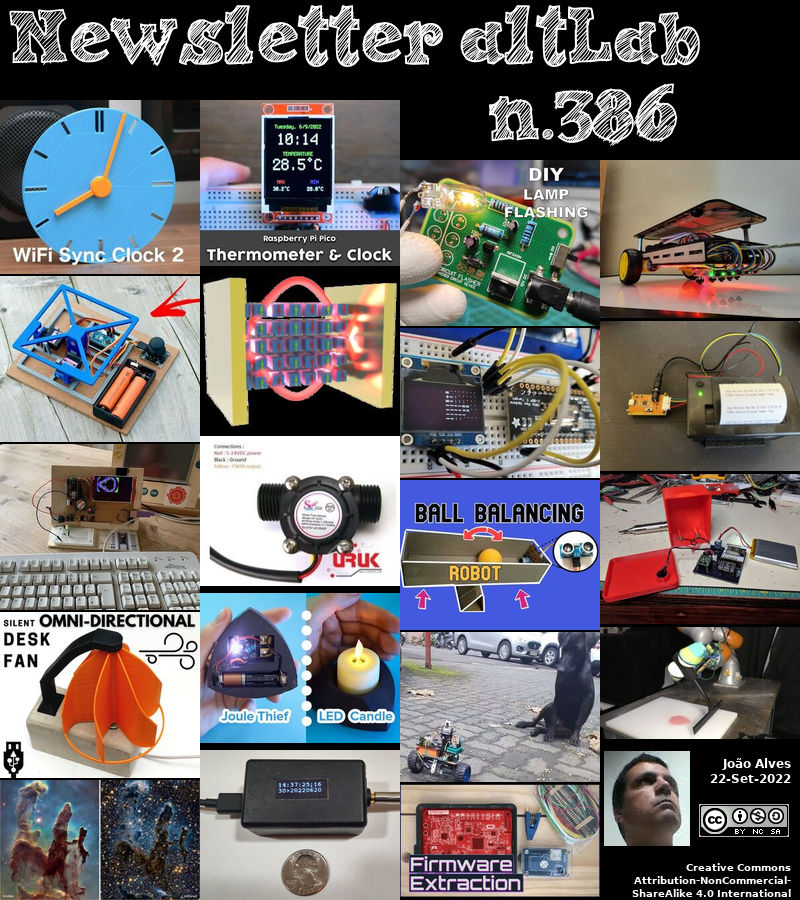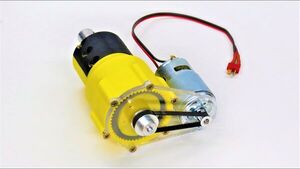2022-09-22 - Nº 386
Editorial
Esta é a Newsletter Nº 386 que se apresenta com o mesmo formato que as anteriores. Se gostar da Newsletter partilhe-a!
Todas as Newsletters encontram-se indexadas no link.
Esta Newsletter tem os seguintes tópicos:
Faz hoje anos que nascia, em 1759, o engenheiro e economista escocês William Playfair. Ele foi pioneiro na representação gráfica de estatísticas, criando o gráfico de linhas, gráfico de barras e gráfico de tartes, embora o seu nome seja pouco conhecido. As suas invenções e patentes incluíam máquinas metalúrgicas, a produção em massa de colheres prateadas, melhoramentos em alfaias agrícolas, e modificação dos arcos para os navios para aumentar a velocidade. Ganhou experiência como aprendiz de Andrew Meikle (inventor da debulhadora) e trabalhando com James Watt e Matthew Boulton (fabricantes de motores a vapor). O livro Playfair Commercial and Political Atlas (1786), que introduziu os seus métodos de exposição gráfica, foi o primeiro grande trabalho a utilizar gráficos estatísticos.
Faz também hoje anos que nascia, em 1791, o físico e químico inglês Michael Faraday. Ele ficou conhecido pelas muitas experiências que contribuíram grandemente para a compreensão do electromagnetismo. Embora fosse um dos maiores experimentalistas, era em grande parte autodidacta. Nomeado por Sir Humphry Davy como seu assistente na Instituição Real, Faraday concentrou-se inicialmente na química analítica, e descobriu o benzeno em 1825. O seu trabalho mais importante foi no campo do electromagnetismo, no qual demonstrou rotação electromagnética e descobriu indução electromagnética (a chave para o desenvolvimento do dínamo eléctrico e do motor). Descobriu também o diamagnetismo e as leis da electrólise. Publicou artigos pioneiros que levaram ao uso prático da electricidade, e defendeu o uso da luz eléctrica em faróis. A unidade que mede a capacitância é o Farad (F) em homenagem a Faraday.
Por fim, faz hoje anos que nascia, em 1959, o astrofísico norte-americano Saul Perlmutter. Ele partilhou (com Brian P. Schmidt e Adam G. Riess) o Prémio Nobel da Física 2011 pela "descoberta da expansão acelerada do Universo através de observações de supernovas distantes". Para este efeito, tinha sido co-fundador (1988) e liderou o Projecto Internacional Supernova Cosmology baseado no Laboratório Nacional Lawrence Berkeley.
Na Newsletter desta semana apresentamos diversas noticias, artigos científicos, projetos de maker e alguns vídeos interessantes. É apresentada a revistar HackSpace Magazine nº 59 de Outubro e os livros "Elements of Programming" e "FreeCAD for Makers".
 João Alves ([email protected])
João Alves ([email protected])
O conteúdo da Newsletter encontra-se sob a licença  Creative Commons Attribution-NonCommercial-ShareAlike 4.0 International License.
Creative Commons Attribution-NonCommercial-ShareAlike 4.0 International License.
Novidades da Semana
Outras Notícias
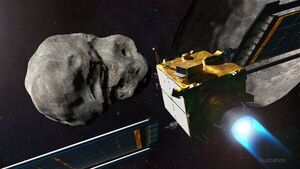
NASA’s Asteroid-Striking DART Mission Team Has JPL Members
"It’s a bold and complex undertaking to try impacting an asteroid. JPL is there to assist with navigators, communications, and more. On Monday, Sept. 26, NASA’s Double Asteroid Redirection Test (DART) mission has the challenging goal of crashing its spacecraft into Dimorphos, a small moonlet orbiting a larger asteroid by the name of Didymos. While the asteroid poses no threat to Earth, this mission will test technology that could be used to defend our planet against potential asteroid or comet hazards that may be detected in the future. Johns Hopkins Applied Physics Laboratory (APL) in Laurel, Maryland, designed and leads the ambitious mission for NASA. But as with many missions, the endeavor calls on expertise from various NASA centers." [...]
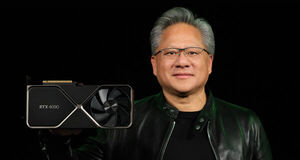
NVIDIA CEO Unveils Next-Gen RTX GPUs, AI Workflows in the Cloud
"Kicking off GTC, Jensen Huang unveils advances in natural language understanding, the metaverse, gaming and AI technologies impacting industries from transportation and healthcare to finance and entertainment. New cloud services to support AI workflows and the launch of a new generation of GeForce RTX GPUs featured today in NVIDIA CEO Jensen Huang’s GTC keynote, which was packed with new systems, silicon, and software. “Computing is advancing at incredible speeds, the engine propelling this rocket is accelerated computing, and its fuel is AI,” Huang said during a virtual presentation as he kicked off NVIDIA GTC. Again and again, Huang connected new technologies to new products to new opportunities – from harnessing AI to delight gamers with never-before-seen graphics to building virtual proving grounds where the world’s biggest companies can refine their products. Driving the deluge of new ideas, new products and new applications: a singular vision of accelerated computing unlocking advances in AI, which, in turn will touch industries around the world. Gamers and creators will get the first GPUs based on the new NVIDIA Ada Lovelace architecture." [...]
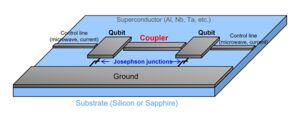
Toshiba’s Double-Transmon Coupler Will Realize Faster, More Accurate Superconducting Quantum Computers
"Researchers at Toshiba Corporation (TOKYO: 6502) have achieved a breakthrough in quantum computer architecture: the basic design for a double-transmon coupler that will improve the speed and accuracy of quantum computation in tunable couplers. The coupler is a key device in determining the performance of superconducting quantum computers. Tunable couplers in a superconducting quantum computer link two qubits and perform quantum computations by turning on and off the coupling between them. Current technology can turn off the coupling of transmon qubits*1 with close frequencies, but this is prone to crosstalk errors that occur on one of the qubits when the other qubit is irradiated with electromagnetic waves for control. In addition, current technology cannot completely turn off coupling for qubits with significantly different frequencies, resulting in errors due to residual coupling. Toshiba has recently devised a double-transmon coupler that can completely turn on and off the coupling between qubits with significantly different frequencies." [...]

Microchip Unveils Industry’s First Terabit-Scale Secure Ethernet PHY Family with Port Aggregation for Enterprise and Cloud Interconnect
"META-DX2+ enables OEMs to double router and switch system capacities with 112G PAM4 connectivity for 800G ports, adds encryption and Class C/D precision timing CHANDLER, Ariz., Sept. 19, 2022 — The demand for increased bandwidth and security in network infrastructure driven by growth in hybrid work and geographical distribution of networks is redefining borderless networking. Led by AI/ML applications, the total port bandwidth for 400G (gigabits per second) and 800G is forecasted to grow at an annual rate of over 50%, according to 650 Group. This dramatic growth is expanding the transition to 112G PAM4 connectivity beyond just cloud data center and telecom service provider switches and routers to enterprise Ethernet switching platforms. Microchip Technology Inc. (NASDAQ: MCHP) is responding to this market inflection with the META-DX2 Ethernet PHY (physical layer) portfolio by introducing a new family of META-DX2+ PHYs. These are the industry’s first solution set to integrate 1.6T (terabits per second) of line-rate end-to-end encryption and port aggregation to maintain the most compact footprint in the transition to 112G PAM4 connectivity for enterprise Ethernet switches, security appliances, cloud interconnect routers and optical transport systems. “The introduction of four new META-DX2+ Ethernet PHYs demonstrates our commitment to supporting the industry transition to 112G PAM4 connectivity powered by our META-DX retimer and PHY portfolio." [...]
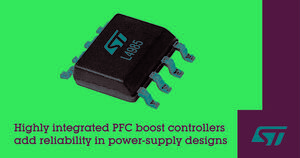
Highly integrated PFC boost controllers from STMicroelectronics eliminate startup-circuit design challenges
"STMicroelectronics’ L4985A/B and L4986A/B power-factor correction (PFC) boost controllers simplify design and enhance flexibility by integrating 800V startup circuitry and additional valuable proprietary features. The built-in high-voltage startup capability saves auxiliary circuitry, allowing a “no aux” design that reduces bill-of-materials costs and ensures reliable starting. These circuits also include internal logic to safely discharge input-filter X capacitors when the AC line is disconnected. This eliminates the power losses incurred in a traditional discharge resistor and simplifies meeting safety regulations such as IEC 61010-1 or IEC 62368-1. The controllers suit multiple applications as PFC pre-regulators in equipment that must meet requirements for harmonic distortion, such as IEC 61000-3-2 and equivalents. These include power supplies for desktop PCs, servers, game consoles, and televisions, industrial and medical switched-mode power supplies (SMPS), and e-scooter chargers." [...]

AMD Ryzen 7020 Series Processors for Mobile Bring High-End Performance and Long Battery Life to Everyday Users
"Today, AMD (NASDAQ: AMD) unveiled the new Ryzen™ 7020 Series and Athlon™ 7020 Series Processor lineup, delivering the perfect balance of performance, productivity, and responsiveness. Built on the “Zen 2” core architecture and featuring AMD RDNA™ 2 graphics, the Ryzen and Athlon 7020 Series Processors for mobile deliver excellent everyday performance and up to 12 hours of battery life1 so users can get the most out of their laptop. “AMD has revolutionized thin and light laptops with unbeatable performance and uncompromising battery life,” said Saeid Moshkelani, senior vice president and general manager, client business unit, AMD. “We are so excited to bring everything that users expect from premium laptops to the mainstream laptop market with the new Ryzen 7020 Series and Athlon 7020 Series Processors for mobile. At any price point, users should feel confident they are getting the best experience possible with AMD.” AMD Ryzen and Athlon 7020 Series Processors for Mobile Built on TSMC’s advanced 6nm manufacturing technology, the new Ryzen and Athlon 7020 Series Processors for mobile offer the perfect balance of speed, style and endurance. With smart battery management and dedicated video and audio playback hardware, systems featuring the Ryzen and Athlon 7020 Series processors are ideal for video conferencing and collaboration, office productivity and multitasking, and connecting with family and friends, when at home or on the go." [...]

Functional Safety Certification Packages for Microchip FPGAs Speed Time to Market
"SmartFusion® 2 and IGLOO® 2 FPGAs now add IEC 61508 certification to their Single Event Upset (SEU) mitigation benefits Systems used in many high-reliability commercial aviation, space, defense, automotive and industrial applications require certification to the IEC 61508 Safety Integrity Level (SIL) 3 functional safety specification. To reduce the cost of this process and accelerate time to market for system developers, Microchip Technology (Nasdaq: MCHP) continues to certify its products and tools to industry safety specifications and has now added IEC 61508 SIL 3 certification packages for two more of its System-on-Chip (SoC) FPGA and FPGA families. “Microchip FPGA families have a broad and historically strong position within the industrial market and are recognized for the high reliability and security of our nonvolatile FPGA technologies,” said Bruce Weyer, corporate vice president of Microchip’s FPGA business unit. “We also have a long history of certifying our products and tools to IEC 61508 SIL 3 and other safety specifications so the end-equipment certification process for our customers is much easier. Adding these packages for our low-power-consumption SmartFusion 2 SoC FPGAs and IGLOO 2 FPGAs is a natural extension for industrial customers who design high-reliability products for the smart grid, automation controllers, process analyzers and other safety-critical applications.” Microchip’s safety packages are built on top of the SEU-immune, Flash-based FPGA fabric of the SmartFusion 2 and IGLOO 2 devices, and these FPGAs are certified by independent safety assessor TÜV Rhineland®. Package deliverables include certification of Microchip’s Libero® SoC Design Suite v11.8 Service Pack 4 and associated development tools, plus 28 Intellectual Property (IP) cores, safety manuals, documentation and device data sheets." [...]

New Webb Image Captures Clearest View of Neptune’s Rings in Decades
"NASA’s James Webb Space Telescope shows off its capabilities closer to home with its first image of Neptune. Not only has Webb captured the clearest view of this distant planet’s rings in more than 30 years, but its cameras reveal the ice giant in a whole new light. Most striking in Webb’s new image is the crisp view of the planet’s rings – some of which have not been detected since NASA’s Voyager 2 became the first spacecraft to observe Neptune during its flyby in 1989. In addition to several bright, narrow rings, the Webb image clearly shows Neptune’s fainter dust bands. “It has been three decades since we last saw these faint, dusty rings, and this is the first time we’ve seen them in the infrared,” notes Heidi Hammel, a Neptune system expert and interdisciplinary scientist for Webb. Webb’s extremely stable and precise image quality permits these very faint rings to be detected so close to Neptune." [...]

NASA’s Juno Will Perform Close Flyby of Jupiter’s Icy Moon Europa
"As the spacecraft makes a close approach of the moon, it is expected to provide valuable science – and remarkable imagery – for NASA’s upcoming Europa Clipper mission. On Thursday, Sept. 29, at 2:36 a.m. PDT (5:36 a.m. EDT), NASA’s Juno spacecraft will come within 222 miles (358 kilometers) of the surface of Jupiter’s ice-covered moon, Europa. The solar-powered spacecraft is expected to obtain some of the highest-resolution images ever taken of portions of Europa’s surface, as well as collect valuable data on the moon’s interior, surface composition, and ionosphere, along with its interaction with Jupiter’s magnetosphere. Such information could benefit future missions, including the agency’s Europa Clipper, which is set to launch in 2024 to study the icy moon. “Europa is such an intriguing Jovian moon, it is the focus of its own future NASA mission,” said Juno Principal Investigator Scott Bolton of the Southwest Research Institute in San Antonio. “We’re happy to provide data that may help the Europa Clipper team with mission planning, as well as provide new scientific insights into this icy world.” With an equatorial diameter of 1,940 miles (3,100 kilometers), Europa is about 90% the size of Earth’s Moon." [...]
Ciência e Tecnologia

Ultracold circuits
"Cooling materials to extremely low temperatures is important for basic physics research as well as for technological applications. By improving a special refrigerator and a low-temperature thermometer, Basel scientists have now managed to cool an electric circuit on a chip down to 220 microkelvin – close to absolute zero. When materials are cooled down to extremely low temperatures, their behaviour often differs strongly from that at room temperature. A well-known example is superconductivity: below a critical temperature some metals and other substances conduct electric current without any losses. At even lower temperatures additional quantum-physical effects can occur, which are relevant for basic research as well as for applications in quantum technologies. However, to reach such temperatures – less than a thousandth of a degree above the absolute zero of 0 Kelvin, or -273.15 degrees Celsius – is exceedingly difficult." [...]

Key Element for a Scalable Quantum Computer
"Physicists from Forschungszentrum Jülich and RWTH Aachen University demonstrate electron transport on a quantum chip Millions of quantum bits are required for quantum computers to prove useful in practical applications. The scalability is one of the greatest challenges in the development of future devices. One problem is that the qubits have to be very close to each other on the chip in order to couple them together. Researchers at Forschungszentrum Jülich and RWTH Aachen University have now come a significant step closer to solving the problem. They succeeded in transferring electrons, the carriers of quantum information, over several micrometres on a quantum chip. Their "quantum bus" could be the key component to master the leap to millions of qubits." [...]
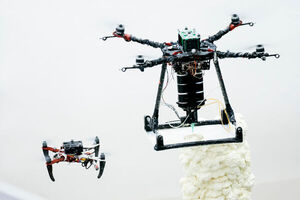
3D printing drones work like bees to build and repair structures while flying
"Imperial College London and Empa researchers have created a fleet of bee-inspired flying 3D printers for building and repairing structures in-flight. The technology could ultimately be used for manufacturing and building in difficult-to-access or dangerous locations such as tall buildings or help with post-disaster relief construction, say the researchers, who publish their work in Nature. 3D printing is gaining momentum in the construction industry. Both on-site and in the factory, static and mobile robots print materials for use in construction projects, such as steel and concrete structures. This new approach to 3D printing uses flying robots, known as drones, that use collective building methods inspired by natural builders like bees and wasps. The drones in the fleet, known collectively as Aerial Additive Manufacturing (Aerial-AM), work co-operatively from a single blueprint, adapting their techniques as they go." [...]

From atomic to nuclear clocks
"Peter Thirolf, Benedict Seiferle and Lars von der Wense describe how recent progress in understanding thorium’s nuclear structure, and new upcoming results, could enable an ultra-accurate nuclear clock with applications in fundamental physics. For the past 60 years, the second has been defined in terms of atomic transitions between two hyperfine states of caesium-133. Such transitions, which correspond to radiation in the microwave regime, enable state-of-the art atomic clocks to keep time at the level of one second in more than 300 million years. A newer breed of optical clocks developed since the 2000s exploit frequencies that are about 105 times higher. While still under development, optical clocks based on aluminium ions are already reaching accuracies of about one second in 33 billion years, corresponding to a relative systematic frequency uncertainty below 1 × 10–18. To further reduce these uncertainties, in 2003 Ekkehard Peik and Christian Tamm of Physikalisch-Technische Bundesanstalt in Germany proposed the use of a nuclear instead of atomic transition for time measurements." [...]
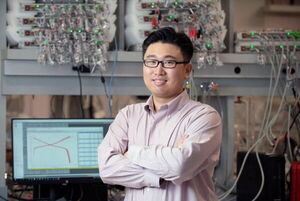
UCI and national lab researchers develop a cobalt-free cathode for lithium-ion batteries
"Researchers at the University of California, Irvine and four national laboratories have devised a way to make lithium-ion battery cathodes without using cobalt, a mineral plagued by price volatility and geopolitical complications. In a paper published today in Nature, the scientists describe how they overcame thermal and chemical-mechanical instabilities of cathodes composed substantially of nickel – a common substitute for cobalt – by mixing in several other metallic elements. “Through a technique we refer to as ‘high-entropy doping,’ we were able to successfully fabricate a cobalt-free layered cathode with extremely high heat tolerance and stability over repeated charge and discharge cycles,” said corresponding author Huolin Xin, UCI professor of physics & astronomy. “This achievement resolves long-standing safety and stability concerns around high-nickel battery materials, paving the way for broad-based commercial applications.” Cobalt is one of the most significant supply chain risks threatening widespread adoption of electric cars, trucks and other electronic devices requiring batteries, according to the paper’s authors. The mineral, which is chemically suited for the purpose of stabilizing lithium-ion battery cathodes, is mined almost exclusively in the Democratic Republic of Congo under abusive and inhumane conditions. “Electric vehicle manufacturers are eager to curtail the use of cobalt in their battery packs not only for cost reduction but to counter the child labor practices used to mine the mineral,” Xin said." [...]
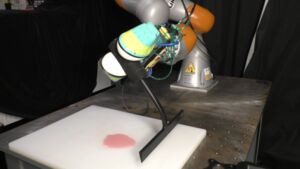
Soft robots that grip with the right amount of force
"Researchers created a system that lets robots effectively use grasped tools with the correct amount of force. Tool use has long been a hallmark of human intelligence, as well as a practical problem to solve for a vast array of robotic applications. But machines are still wonky at exerting just the right amount of force to control tools that aren’t rigidly attached to their hands. To manipulate said tools more robustly, researchers from MIT’s Computer Science and Artificial Intelligence Laboratory (CSAIL), in collaboration with the Toyota Research Institute (TRI), have designed a system that can grasp tools and apply the appropriate amount of force for a given task, like squeegeeing up liquid or writing out a word with a pen. The system, dubbed Series Elastic End Effectors, or SEED, uses soft bubble grippers and embedded cameras to map how the grippers deform over a six-dimensional space (think of an airbag inflating and deflating) and apply force to a tool. Using six degrees of freedom, the object can be moved left and right, up or down, back and forth, roll, pitch, and yaw." [...]
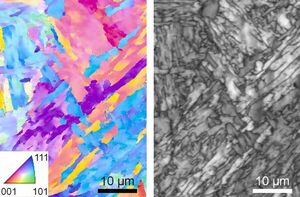
Researchers Uncover How to 3D-Print One of the Strongest Stainless Steels
"For airliners, cargo ships, nuclear power plants and other critical technologies, strength and durability are essential. This is why many contain a remarkably strong and corrosion-resistant alloy called 17-4 precipitation hardening (PH) stainless steel. Now, for the first time ever, 17-4 PH steel can be consistently 3D-printed while retaining its favorable characteristics. A team of researchers from the National Institute of Standards and Technology (NIST), the University of Wisconsin-Madison and Argonne National Laboratory has identified particular 17-4 steel compositions that, when printed, match the properties of the conventionally manufactured version. The researchers’ strategy, described in the journal Additive Manufacturing, is based on high-speed data about the printing process they obtained using high-energy X-rays from a particle accelerator. The new findings could help producers of 17-4 PH parts use 3D printing to cut costs and increase their manufacturing flexibility." [...]

How do magnetic fields affect star formation and high-energy-density lab experiments?
"Rochester researchers hope to explain how the fields occur in plasma instabilities. The famous Pillars of Creation in the Eagle Nebulae—a star nursery—are believed to result from the hydrodynamic instabilities that form when plasmas are exposed to high intensity light from neighboring stars. Something very similar occurs—at a minute scale—when materials are imploded by converging laser beams during high-energy-density physics and fusion experiments at the Laboratory for Laser Energetics at the University of Rochester. “You shine the lasers, you evaporate mass off of the surface, and push everything radially inwards, and you have these hydrodynamic instabilities that have modulations similar to the Pillars,” says Hussein Aluie, associate professor of mechanical engineering at Rochester’s Hajim School of Engineering & Applied Sciences. To what extent do plasmas undergoing instabilities generate magnetic fields, and how do those magnetic fields further influence the plasma instabilities? “It is well known that magnetic fields can strongly impact how plasmas behave,” Aluie says, “but the mechanisms for self-generation and amplification of magnetic fields in different types of plasma continue to be a mystery.” With funding from a $390,000 National Science Foundation grant, Aluie will address this mystery with co-PI Riccardo Betti, LLE’s chief scientist and Robert L. McCrory Professor, and Fernando Garcia-Rubio, assistant scientist at the LLE and in Aluie’s Turbulence and Complex Flow Group, who has been developing the theory for this work." [...]
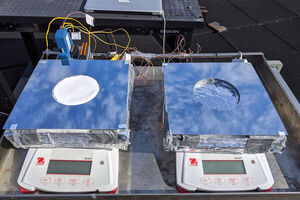
Passive cooling system could benefit off-grid locations
"Relying on evaporation and radiation — but not electricity — the system could keep food fresh longer or supplement air conditioning in buildings. As the world gets warmer, the use of power-hungry air conditioning systems is projected to increase significantly, putting a strain on existing power grids and bypassing many locations with little or no reliable electric power. Now, an innovative system developed at MIT offers a way to use passive cooling to preserve food crops and supplement conventional air conditioners in buildings, with no need for power and only a small need for water. The system, which combines radiative cooling, evaporative cooling, and thermal insulation in a slim package that could resemble existing solar panels, can provide up to about 19 degrees Fahrenheit (9.3 degrees Celsius) of cooling from the ambient temperature, enough to permit safe food storage for about 40 percent longer under very humid conditions. It could triple the safe storage time under dryer conditions. The findings are reported today in the journal Cell Reports Physical Science, in a paper by MIT postdoc Zhengmao Lu, Arny Leroy PhD ’21, professors Jeffrey Grossman and Evelyn Wang, and two others." [...]
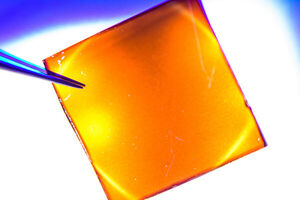
Solvent study solves solar cell durability puzzle
"Rice University engineers say they’ve solved a long-standing conundrum in making stable, efficient solar panels out of halide perovskites. It took finding the right solvent design to apply a 2D top layer of desired composition and thickness without destroying the 3D bottom one (or vice versa). Such a cell would turn more sunlight into electricity than either layer on its own, with better stability. Chemical and biomolecular engineer Aditya Mohite and his lab at Rice’s George R. Brown School of Engineering reported in Science their success at building thin 3D/2D solar cells that deliver a power conversion efficiency of 24.5%. That’s as efficient as most commercially available solar cells, Mohite said. “This is really good for flexible, bifacial cells where light comes in from both sides and also for back-contacted cells,” he said." [...]
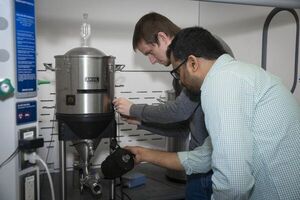
LANL is brewing beer at the speed of sound
"As beer lovers sip their favorite IPAs on a weekend or after a long day’s work, they might be unaware — and who can blame them? — of the complexity of the brewing process and all the things that can go wrong in getting that tasty beverage from the recipe to the restaurant table. Especially in many of the more than 8,800 craft breweries in the United States, the art of brewing is still very much a manual process, relying on sampling, testing and tinkering. As a scientist on an acoustic-science research team at Los Alamos National Laboratory, I have long been interested in acoustic sensor technology. Developments in this science apply to the oil and gas sectors and other industries, but we saw the potential in the brewing industry. Visiting craft breweries in the Denver area last year, as well as canvassing many of the breweries here in New Mexico, we heard about their challenges and assessed the potential for acoustic-sensor technology in this fast-growing industry that nonetheless has complex technical challenges." [...]

New 3D printing process offers novel energy storage design options
"A team from UNSW Sydney has developed a way to 3D print strong, high-conducting solid polymer electrolytes into custom shapes. UNSW engineers have developed a process to print solid-state polymer electrolytes into any shape desired for use in energy storage. The research team from the School of Chemical Engineering led by Professor Cyrille Boyer, including Dr Nathaniel Corrigan and Kenny Lee – say the 3D printing process of such material could be particularly useful in future medical devices where small, intricately designed energy storage offers a number of benefits. Solid-state electrolytes are a key component in solid-state batteries, although traditionally they have suffered from poor performance due to low ionic conductivities or poor mechanical properties. However, in a paper published in Advanced Materials, the team from UNSW reports their 3D printed solid polymer electrolyte (SPE) offers high conductivity, as well as robust strength. This means the solid-state electrolytes can potentially be used as the actual structure of a device, creating a range of conceivable design opportunities, particularly for future medical products." [...]
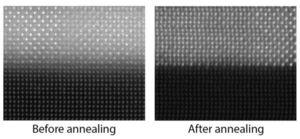
Heat-resistant nanophotonic material could help turn heat into electricity
"A new nanophotonic material has broken records for high-temperature stability, potentially ushering in more efficient electricity production and opening a variety of new possibilities in the control and conversion of thermal radiation. Developed by a University of Michigan-led team of chemical and materials science engineers, the material controls the flow of infrared radiation and is stable at temperatures of 2,000 degrees Fahrenheit in air, a nearly twofold improvement over existing approaches. The material uses a phenomenon called destructive interference to reflect infrared energy while letting shorter wavelengths pass through. This could potentially reduce heat waste in thermophotovoltaic cells, which convert heat into electricity but can’t use infrared energy, by reflecting infrared waves back into the system. The material could also be useful in optical photovoltaics, thermal imaging, environmental barrier coatings, sensing, camouflage from infrared surveillance devices and other applications. “It’s similar to the way butterfly wings use wave interference to get their color." [...]
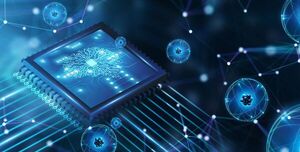
Conventional Computers Can Learn to Solve Tricky Quantum Problems
"There has been a lot of buzz about quantum computers and for good reason. The futuristic computers are designed to mimic what happens in nature at microscopic scales, which means they have the power to better understand the quantum realm and speed up the discovery of new materials, including pharmaceuticals, environmentally friendly chemicals, and more. However, experts say viable quantum computers are still a decade away or more. What are researchers to do in the meantime? A new Caltech-led study in the journal Science describes how machine learning tools, run on classical computers, can be used to make predictions about quantum systems and thus help researchers solve some of the trickiest physics and chemistry problems. While this notion has been proposed before, the new report is the first to mathematically prove that the method works in problems that no traditional algorithms could solve." [...]
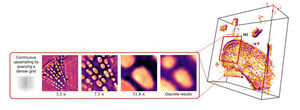
Machine learning generates 3D model from 2D pictures
"Neural field network doesn’t need to be trained on other samples. Researchers from the McKelvey School of Engineering at Washington University in St. Louis have developed a machine learning algorithm that can create a continuous 3D model of cells from a partial set of 2D images that were taken using the same standard microscopy tools found in many labs today. Their findings were published Sept. 16 in the journal Nature Machine Intelligence. “We train the model on the set of digital images to obtain a continuous representation,” said Ulugbek Kamilov, assistant professor of electrical and systems engineering and of computer science and engineering. “Now, I can show it any way I want. I can zoom in smoothly and there is no pixelation.” The key to this work was the use of a neural field network, a particular kind of machine learning system that learns a mapping from spatial coordinates to the corresponding physical quantities." [...]

CCNY researchers create new magnetic quasiparticle
"From The City College of New York’s Center for Discovery and Innovation and the Physics Department comes news of a new type of magnetic quasiparticle created by coupling light to a stack of ultrathin two-dimensional magnets. This achievement sprouting from a collaboration with the University of Texas at Austin lays the foundation for an emergent strategy to artificially design materials by ensuring their strong interaction with light. "Implementing our approach with magnetic materials is a promising path towards efficient magneto-optical effects,” said CCNY physicist Vinod M. Menon, whose group led the study. “Achieving this goal can enable their use for applications in everyday devices like lasers, or for digital data storage.” Dr. Florian Dirnberger, the lead author of the study, believes that their work exposed a largely unexplored realm of strong interactions between light and magnetic crystals. “Research in recent years brought forth a number of atomically flat magnets that are exceptionally well-suited to be studied by our approach,” he noted. Looking ahead, the team plans to extend these investigations to understand the role of the quantum electrodynamical vacuum when quantum materials are placed into optical cavities." [...]

New technology for aviation materials to allow adjusting their properties
"Russian scientists have proposed a technology for a lightweight and durable composite material creation. It is based on a polymer matrix and carbon fibers. Such material can be used in aircraft construction to create elements of a power set and hull structures. The developed composite can be easily recycled or disposed of, which makes it more environmentally friendly than its analogues. The study has been published in Polymers. Carbon fiber is a unique material consisting almost entirely of carbon atoms." [...]

The Magneto-Optic Modulator
"Researchers create a device to streamline interactions between ultra-cold and room-temperature computers. Many state-of-the-art technologies work at incredibly low temperatures. Superconducting microprocessors and quantum computers promise to revolutionize computation, but scientists need to keep them just above absolute zero (-459.67° Fahrenheit) to protect their delicate states. Still, ultra-cold components have to interface with room temperature systems, providing both a challenge and an opportunity for engineers. An international team of scientists, led by UC Santa Barbara’s Paolo Pintus(link is external), has designed a device to help cryogenic computers talk with their fair-weather counterparts. The mechanism uses a magnetic field to convert data from electrical current to pulses of light." [...]
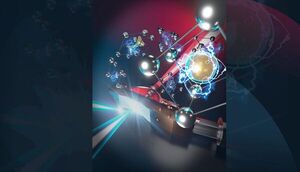
Under pressure: solid matter takes on new behavior
"Investigating how solid matter behaves at enormous pressures, such as those found in the deep interiors of giant planets, is a great experimental challenge. To help address that challenge, Lawrence Livermore National Laboratory (LLNL) researchers and collaborators took a deep dive in understanding these extreme pressures. The work was just published in Nature Physics with LLNL scientist Martin Gorman as lead author. “Our results represent a significant experimental advance; we were able to investigate the structural behavior of magnesium (Mg) at extreme pressures — over three times higher than at the Earth’s core — which were previously only accessible theoretically,” Gorman said. “Our observations confirm theoretical predictions for Mg and demonstrate how TPa pressures — 10 million times atmospheric pressure — force materials to adopt fundamentally-new chemical and structural behaviors.” Gorman said that modern computational methods have suggested that core electrons bound to neighboring atoms begin to interact at extreme pressures, causing the conventional rules of chemical bonding and crystal-structure formation to break down. “Perhaps the most striking theoretical prediction is the formation of high-pressure ‘electrides’ in elemental metals, where valence-band free electrons are squeezed into localized states within the empty spaces between ions to form pseudo-ionic configurations,” he said." [...]
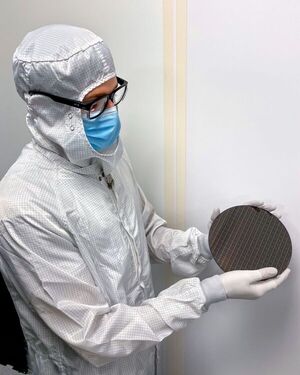
Brains on board: Smart microrobots walk autonomously
"A collaborative effort has installed electronic “brains” on solar-powered robots that are 100 to 250 micrometers in size – smaller than an ant’s head – so that they can walk autonomously without being externally controlled. While Cornell researchers and others have previously developed microscopic machines that can crawl, swim, walk and fold themselves up, there were always “strings” attached; to generate motion, wires were used to provide electrical current or laser beams had to be focused directly onto specific locations on the robots. “Before, we literally had to manipulate these ‘strings’ in order to get any kind of response from the robot,” said Itai Cohen, professor of physics in the College of Arts and Sciences. “But now that we have these brains on board, it’s like taking the strings off the marionette. It’s like when Pinocchio gains consciousness.” The innovation sets the stage for a new generation of microscopic devices that can track bacteria, sniff out chemicals, destroy pollutants, conduct microsurgery and scrub the plaque out of arteries. The team’s paper, “Microscopic Robots with Onboard Digital Control,” published Sept. 21 in Science Robotics." [...]
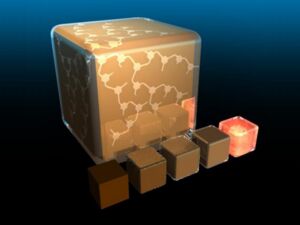
Wrapping of nanosize copper cubes can help convert carbon dioxide into other chemicals
"Researchers found a new way to reduce carbon dioxide (CO2) emissions by wrapping copper nanocubes with an organic layer, solving instability and selectivity problems with copper nanocubes in catalysis, and improving how this electrocatalyst converts CO2 into organic molecules. As the need to mitigate climate change accelerates, scientists are trying to find new ways to reduce carbon dioxide emissions. One process, called electrochemical reduction or electrolysis, uses electricity and a catalyst to convert carbon dioxide into organic products that can be used in other ways. Unlike conversion between water and hydrogen, chemical recycling of carbon dioxide can produce various useable products because carbon can develop vast varieties of organic structures. One way to achieve electrochemical reduction of carbon dioxide uses very tiny pieces of copper. While bulk copper metal has known to convert carbon dioxide into various organic molecules, these small pieces of copper can further improve catalytic activity not only by the increase of its surface area but also by the unique electronic structure of copper emerged from nanosizing." [...]
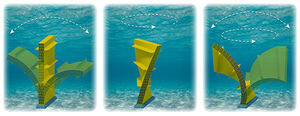
Patented Wave Energy Technology Gets Its Sea Legs
"Imagine this: Clothing that charges your smart watch as you walk, buildings that vibrate in the wind and power your lights, a road that extracts energy from the friction created by moving cars, and flexible structures that change shape in ocean waves to generate clean electricity for communities around the world. It is not science fiction. Someday, we could harness these naturally occurring energy sources thanks to a fledgling technology domain that just earned its first patent: distributed embedded energy converter technologies (or DEEC-Tec, pronounced deck-tech, for short). The invention’s first patent is specifically for applications in marine renewable energy—clean power generated from ocean and river waves, currents, and tides. But DEEC-Tec could eventually transform sources of everyday energy, including almost all physical motions or dynamic shape changes, into electricity or other forms of usable energy. “The DEEC-Tec domain has legs and is growing,” said Blake Boren, a senior engineer at the National Renewable Energy Laboratory (NREL) and the lead inventor on the patent along with Jochem Weber, chief engineer for NREL’s water power program." [...]
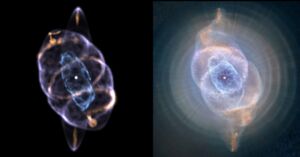
Cat’s Eye Nebula seen in 3D
"Researchers have created the first computer-generated three-dimensional model of the Cat's Eye Nebula, revealing a pair of symmetric rings encircling the nebula’s outer shell. The rings’ symmetry suggests they were formed by a precessing jet, providing strong evidence for a binary star at the centre of the nebula. The study was led by Ryan Clairmont, who recently completed secondary school in the United States, and is published in Monthly Notices of the Royal Astronomical Society. A planetary nebula forms when a dying solar-mass star ejects its outer layer of gas, creating a colourful, shell-like structure distinctive to these objects. The Cat’s Eye Nebula, also known as NGC 6543, is one of the most complex planetary nebulae known. It is just over 3,000 light-years away from Earth, and can be seen in the constellation Draco." [...]
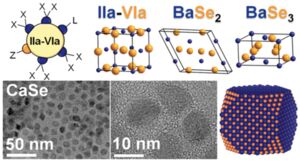
Fundamental research improves understanding of new optical materials
"Research into the synthesis of new materials could lead to more sustainable and environmentally friendly items such as solar panels and light emitting diodes (LEDs). Scientists from Ames National Laboratory and Iowa State University developed a colloidal synthesis method for alkaline earth chalcogenides. This method allows them to control the size of the nanocrystals in the material. They were also able to study the surface chemistry of the nanocrystals and assess the purity and optical properties of the materials involved. Alkaline earth chalcogenides are a type of semiconductor that is of growing interest among scientists. They have a variety of possible applications such as bioimaging, LEDs, and thermal sensors." [...]
Documentação
A documentação é parte essencial do processo de aprendizagem e a Internet além de artigos interessantes de explorar também tem alguma documentação em formato PDF interessante de ler. Todos os links aqui apresentados são para conteúdo disponibilizado livremente pelo editor do livro.

FreeCAD for Makers
"FreeCAD is the number one free software 3D design program, and this PDF guide is the best way to get started with it. We’ll take you from absolute beginnner to advanced user, going from the basics of drawing a line and making it 3D all the way to parametric design, importing objects from photographs, designing for sheet metal, and loads more. Because FreeCAD is free software, its users can add to it, writing extensions to the software to suit their needs. These add-ons, known as workbenches, cover a range of uses, including PCB design, pipes, timber-framing, architectural design… the list of practical use cases goes on and on. So, whatever you’re interested in building, you’ll find a FreeCAD workbench for it. " [...]
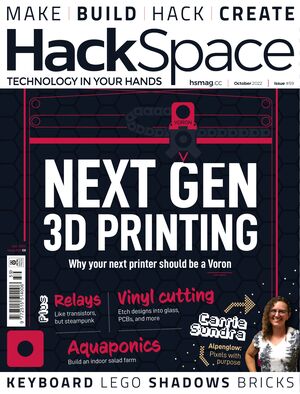
HackSpace magazine #59
"You might think that the next big leap in 3D printing would come in the form of a pristine white box from a high-end manufacturing facility. You’d be wrong. The hot new thing in 3D printing is an open source machine you can put together yourself in your kitchen. Come with us, and find out why your next printer should be a Voron. - Grow food to feed yourself during the coming apocalypse - Use a Raspberry Pi Pico to monitor houseplants - Cut circuits out of copper tape - Build more with bricks" [...]
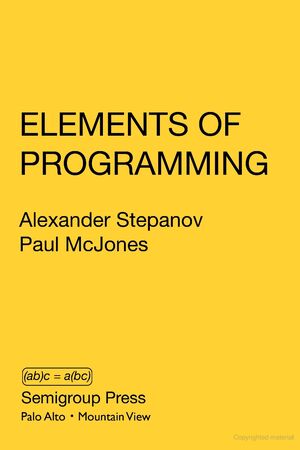
Elements of Programming
"This book applies the deductive method to programming by affiliating programs with the abstract mathematical theories that enable them to work. Specification of these theories, algorithms written in terms of these theories, and theorems and lemmas describing their properties are presented together. The implementation of the algorithms in a real programming language is central to the book. While the specifications, which are addressed to human beings, should, and even must, combine rigor with appropriate informality, the code, which is addressed to the computer, must be absolutely precise even while being general. As with other areas of science and engineering, the appropriate foundation of programming is the deductive method. It facilitates the decomposition of complex systems into components with mathematically specified behavior." [...]
Projetos Maker
Diversos Projetos interessantes.
Self Balancing WiFi Controlled Robot with PanTilt Camera
"This self balancing mobile robot with pan & tilt camera can be navigated remotely from host PC without the need to be in line of sight. Self-balancing mobile robots (SBMRs) are unique among others, just because of their ability to balance on a given fixed position. A typical SBMR measures inclination angle with the combination of accelerometer and gyroscope measurements and corrects itself by moving forward or backward to make the angle zero. Proportional-Integral-Derivative (PID) controller is used for deciding how much movement is required and at what rate to quickly correct the angle drift and stabilize the robot. Things become challenging when such a robot is to be navigated (moved or rotated) manually from remote location. This project demonstrates how to build a basic WiFi remote controlled 2 wheeled SBMR that has an on-board WiFi camera mounted on a servos powered pan & tilt assembly." [...]
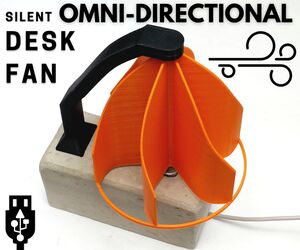
Silent Omni-Directional Desk Fan
" Hello fellow makers, This is one of those projects that started of as one thing and ended up being something completely different.I started wanting to make a small spiral wind turbine that would charge up a supercapacitor and after a lot of failed prints trying to print an Archimedes screw, I designed this easy to print rotor.Unfortunately these didn't work nearly as well as the Archimedes screw but I was still interested in seeing how well balanced it would be so I pushed it onto a motor shaft and hooked it up to a battery...and well I immediately decided it was going to become a desk fan!Not only is it whisper quiet but it gives a gentle omni-directional breeze. Join me to see how you can make your own... To make your own you will need the following: - Access to a 3D printer - Casting concrete mix - 5v DC Motor - 6mm I.D. 686 bearing - 6mm stainless steel rod - An old USB cable - Adhesive - Material for a mold I used an old tea box for this project" [...]

ESP8266 Smart Shoe (pedometer)
"Smart step counter shoe using ESP8266, Infrared Sensor and a LiPo battery. In this project, we will make a smart shoe which can count the number of steps taken and approximate distance walked. It requires the Blynk App and a Wifi Connection. The IR sensor will send a signal to Nodemcu when shoe is lifted from ground. " [...]

Water Flow Meter
"A small, simple and low-cost water flow meter is designed, built and tested using a Programmable Mixed-signal Matrix. Introduction An accurate, small, and low-cost liquid flow meter can be easily made using GreenPAK components. In this application note we present a water flow meter that continuously measures the water flow and displays it on three 7-segment displays. The flow sensor measurement range is from 1 to 30 liters per minute. The output of the sensor is a digital PWM signal with a frequency proportional to the water flow rate. Three GreenPAK Programmable Mixed-Signal Matrix SLG46533 ASICs count the number of pulses within a base time T. This base time is calculated such that the number of pulses is equal to the flow rate in that period, then this calculated number is displayed on the 7-segment displays." [...]
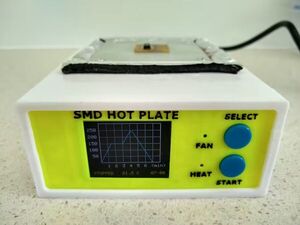
SMD Reflow Hot Plate
"A DIY temperature controlled Hot Plate for soldering SMD components. Story Over the years, electronic components have changed both in terms of size and also their footprint. More and more designs incorporate or solely use surface mount components (SMD) rather than the more bulky through hole components. In the assembly of printed circuit boards, pick-and-place machines replace the older insertion machines. They are faster and more versatile. SMD components also use less solder." [...]

Speed Reading LTC
"An adaptive decoder for LTC data This is my third (and probably last) post on the topic of Arduino interrupts and timers. In the first two, we discovered how to generate regular interrupts with precise timing, then how to use that heartbeat to bit-bang a serial data signal known as Linear Time Code (LTC). In this post we’ll use an interrupt and a timer to decode an LTC stream at a range of speeds. There are lots of line codes, serial protocols and the like, each tailored for a particular use. Some strive for speed of data transfer, with tight tolerances and rigid standards. Some are point-to-point, some shared access, some real-time and so on." [...]

12V Lamp Flashing Circuit
"Here is a project that involves the electric side of your bike or car! we are building a 12V Bulb flashing circuit and I fully documented the necessary steps to achieve a working circuit for such purpose. You will not need advanced electronics skills, the minimum knowledge are enough to understand the circuit diagram and I built the circuit board around through hole components (the big ones) then it will be a bit easy for you in terms of circuit assembly and test. Supplies: The hardware needed here is mainly used during the circuit assembly so you will use the Vise to hold the Circuit board the the tweezers will assist you placing the electronics components in their placements on the board, the solder iron and the solder core spool are obviously needed for the parts soldering. Before moving to the circuit design it is always recommended to test the circuit in a breadboard to make sure that everything is okay and you are using the appropriate components in the appropriate connection, I tried the circuit on my breadboard and I used 12V DC power from my "Lab Power Supply" as same as provided from car 12V battery source, remember that in our circuit we are aiming to flash 12V Bulbs not LEDs, the ones used in the schematic will represent the Bulb output connection since I can't insert Bulb icon so I used the LEDs symbol. I got promessing results after getting the circuit powered from the 12V power entry and the Bulb started flashing in a defined frequency that you can adjust by adjusting the Capacitor value of C1 (100uF)." [...]
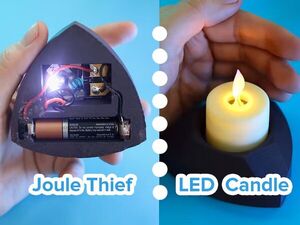
Joule Thief LED Tea Light Adapter
"Adapt your LED tea lights to run on "dead" batteries with this pretty holder! Earlier this year, I created a circuit board for the classic "Joule Thief" circuit, which allows you to run small projects off of nearly-dead batteries (including AA, AAA, and CR2032). I've now combined that PCB with a 3D-printed holder for LED tea lights; with a few small modifications, the lights will now run off of "dead" batteries and can be switched on and off from the bottom of the holder. Let's go! " [...]

Wireless, Battery-Powered, Water Detector
"A water detector powered by a LiPO battery that transmits its status and notifications via MQTT to Home Assistant. About A while back my indoor air conditioner air handler's condensation pipe clogged and caused a small flood. Thankfully we were home and so it didn't cause much damage. So instead of being sensible and getting a $15 water alarm from Home Depot, I decided to spend an inordinate amount of time, money, and effort into creating a water alarm device I could put anywhere and notify me if a water leak happens again. My version will not only screech an annoying pitch at me but will also send me a notification to my Home Assistant which will let me know via phone and email. Oh.. and it should run on a 2500 mAh LiPO battery for about 2439 hours or around 101 days and 15 hours (according to http://www.of-things.de/battery-life-calculator.php) Main Features - Battery powered - No need to run power cables to the device." [...]
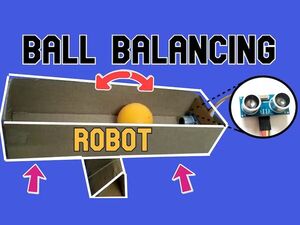
Ball Balancing Robot | Arduino Object Detection Via OpenCV
"This is a ball-balancing robot. It will try to balance the ball in the middle with Object Detection & Image Recognition through Arduino & Python. We have used distance sensors and image recognition techniques to keep it balanced. Why did you decide to make it? I wanted to balance a ping-pong ball in the middle of a plane, to do so I made this robot. How does it work?" [...]
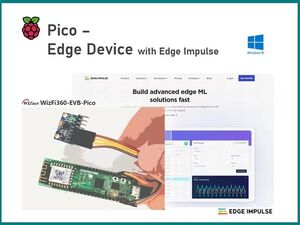
How to setup Pico as Edge device with Edge Impulse
"This is how to start to make Pico as ML model mounted Edge device. In this project, I would like to introduce embedded ML solution provider. Machine learning is a high-spec data operation that was possible on a high-spec computer or cloud system. However, there are many business models that make this possible even at the embedded level recently, such as TinyML. And I think this market will bring many possibilities in the future. I recently discovered a software ML platform service called Edge Impulse." [...]
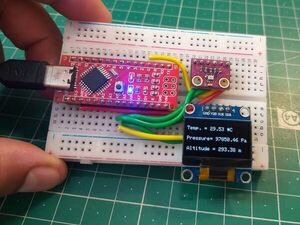
Temperature /Pressure meter using Arduino
"A small but effective sensor which can measure temperature and pressure and then mark those readings for weather forecasting. Today we are going to make a minimal pressure sensor integrated with temperature sensor. This pressure sensor is also able to measure the approx. altitude level. The main idea is to make it simple and to keep the PCB as small as possible. There are many temperature sensors are available in market which offers a lot more precision level, but I choose BMP280 for the project." [...]
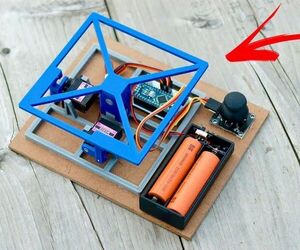
Build DIY Maze Game Using Arduino
"In this project, we will be building a maze game using Arduino. Arduino is an open source electronics platform based on easy-to-use hardware and software. It's intended for anyone making interactive projects. In this project, we will be using Arduino to create a Maze Solver. The Arduino will be programmed to navigate through a Maze, Components - Arduino (Any board type) - Jumper wires - 2X servo motor 9g - Joystick module Tools - 3D Printer - Laser Cutting - Hot glue" [...]
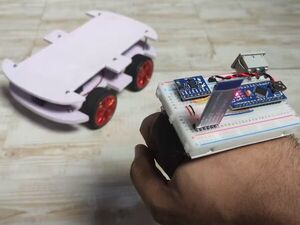
Hand Gesture Control Robot Via bluetooth
"How to Make Hand Gesture Control Robot Via bluetooth | Arduino Hand Gesture Control Robot" [...]

Raspberry Pi Pico Thermometer & Clock
"Dear friends welcome to another tutorial! Today we are going see how to build this low-cost real-time clock and thermometer with a color TFT display using CircuitPython on a Raspberry Pi Pico board. 6 years ago, I built a similar project using an Arduino Uno board and the Arduino IDE. Now that new, much faster boards are available, we can use CircuitPython, an implementation of Python for microcontrollers, to build the same project.Is CircuitPython a good choice for this project? Lets find out. Supplies: - Display - Raspberry Pi Pico - RTC DS3231 - A small Breadboard - Wires" [...]
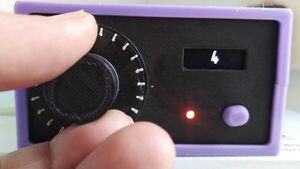
Combination Password Locker
"Protect your passwords with this unique password locker. Once unlocked you can automatically send Website credentials via Bluetooth. This project came about after playing with a rotary encoder and wondering how it could become the basis for a rotary combination lock. I started out with a knob with numbers like the rotary combination lock on a safe. What I found was that no matter how much the rotary encoder contacts were debounced, very slow or very fast rotations would cause the code to lose synchronization with the numbers on the dial. I tried various 20 step and 24 step encoders and they all got out of synchronization with the code." [...]

Thermal Printer Controller Hardware
"Anthe is a Wireless Thermal Printer controller over WiFi and Bluetooth. It is based on ESP32-C3-FH4 Microcontroller. Features include - - Programmable WiFi and Bluetooth Connectivity for Thermal Printer - Onboard logic level shifter for 5V Printer operation. - Onboard Printer power supply connector - USB-C Port for programming - Onboard programmable RGB and normal LED indicators - Onboard WiFi and Bluetooth Antenna - Compact size - Powered by ESP32-C3-FH4 Microcontroller" [...]
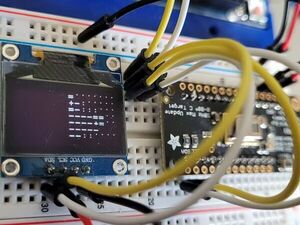
Thermal camera with 0.96 oled monochrome display
"Simple thermal camera with monochrome display. Thanks for checking out the project. I always wanted to have a thermal imaging ability but "grown up" thermal cameras are a rather pricey piece of equipment. So I decided to build it my self. It appeared that AGM8833 IR sensor is within my reach so I decided to give it a try. With the sensor at hand I start exploring display options." [...]

KITT: a Line Following Robot
"The purpose of this project is to develop an autonomous-line following vehicle for robotics/transport purposes. The vehicle may be used as a general robotics platform onto which other electronics may be added or explored. KITT uses 5 IR sensors to detect the position of the line. It is driven using two geared DC motors, with a swiveling caster wheel in the front. The system is powered using 8 AA batteries. This project was a joint effort with myself andAndrew Prata." [...]

USB PD Adapter
"The USB PD Adapter is a USB Power Delivery trigger and monitoring board that enables you to use almost any USB Type-C PD power supply to run your projects with different selectable voltages and high currents. Important values such as voltage, current, power and energy are displayed on the OLED. The USB PD Adapter is based on the cheap and easy-to-use CH224K multi fast charging protocol power receiving chip, the INA219 voltage and current sensor IC, and an ATtiny204, 214, 404, 414, 804, 814, 1604 or 1614 microcontroller. " [...]

A Arduino RP2040 Standalone IoT Computer Running BASIC
"This instructable is about building standalone computers running a BASIC dialect suitable for IoT and interactive work. It uses low cost components that are readily available and can be integrated without much difficulty. So why running BASIC on a microcontroller? Everyone who has programmed on 80s microcontrollers misses one thing on modern computer. It is the ease of use when you want to do something quickly. You could just type in a small program interactively, debug it and step by step extend it." [...]

WiFi Sync Clock 2
"Two hand analog clock with automatic time adjustment using NTP via WiFi. Contrary to the formerWiFi Sync Clock, this clock works normally with monotonic CW rotation (except origin alignment once a day). - It resets the position of hands once a day at 0:00 (and initialization period after power on). The hands of the clock rotates CCW (counter clockwise) and stopped mechanically at 0:00. - Owing to the special hook mechanism, it can precisely align the position of the hands. - ESP32 microcontroller connects to the time server (ntp server) via WiFi." [...]
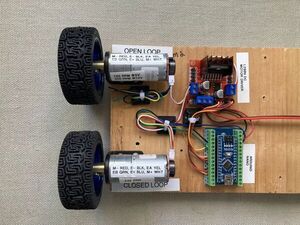
DC Motor Open Loop Vs Closed Loop Demonstrator
"This is a hands-on demonstration of DC Motor Open Loop vs Closed Loop control. Students can simply touch the tires (or use a pencil etc.) and feel the difference between them. There are two very low power motors/tires. One has Open Loop control, and is not as strong.The other has Closed Loop control and increases the voltage when you interfere to try and keep the speed constant. Both can be stopped easily if you grab hard enough, but you can feel the difference." [...]
Secção Videos
Videos interessantes.
That's all Folks!



